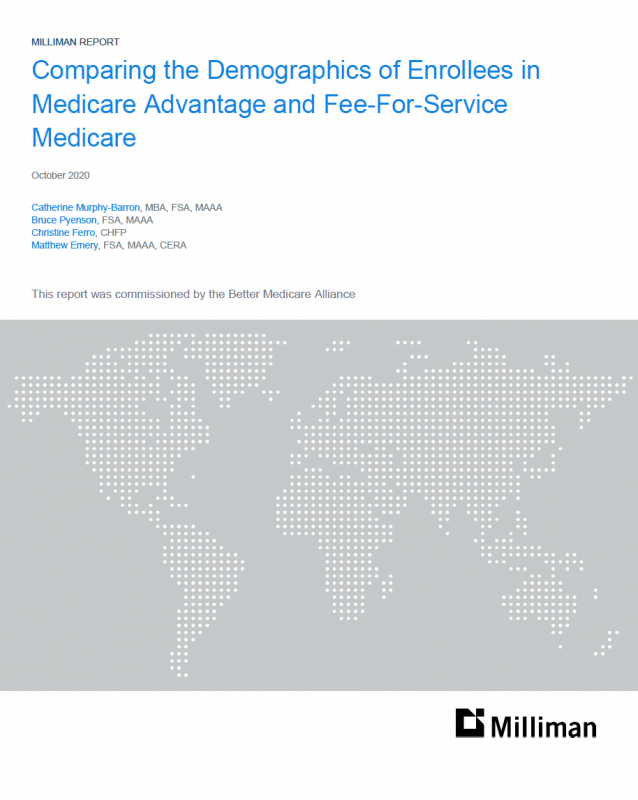New Report Shows Significant Increase in Medicare Advantage Enrollment Among Minority and Dually-Eligible Beneficiaries
Since 2013, Medicare Advantage enrollment grew by 111% among minority beneficiaries and 125% among dual-eligible beneficiaries
Washington, D.C. – As Medicare’s annual open enrollment season begins, new findings commissioned by Better Medicare Alliance’s Center for Innovation in Medicare Advantage and released by the actuarial firm Milliman examine the dramatic growth in Medicare Advantage enrollment over recent years, with minority and dually-eligible beneficiaries among those most drawn to Medicare Advantage.
The report shows a 60% increase in Medicare Advantage enrollment from 2013 to 2019, while Traditional Medicare saw a 5% enrollment increase during the same timeframe.
Minority beneficiary enrollment increased by 111%, with 2019 minority beneficiaries comprising 31.5% of Medicare Advantage enrollment. What’s more, Medicare Advantage experienced better retention of minority beneficiaries than Traditional Medicare between 2013 and 2019, with 85% of those beneficiaries staying in Medicare Advantage, compared to 71% in Traditional Medicare.
Dually-eligible beneficiaries – those who qualify for both Medicare and Medicaid – increasingly chose Medicare Advantage to meet their health coverage needs as well. Enrollment among this cohort in Medicare Advantage jumped 125% from 2013 to 2019, even as it dropped by more than 5% in Traditional Medicare.
“As Medicare’s annual open-enrollment season begins, this independent report offers an eye-opening look at Medicare Advantage’s explosive growth – including the minority and dually-eligible beneficiaries who have made an active choice to entrust their health to the high-quality, value-based care uniquely found in Medicare Advantage,” said Allyson Y. Schwartz, President and CEO of the Better Medicare Alliance. “More than 60% of minority beneficiaries from 2013 to 2019 chose Medicare Advantage. And with dramatic growth in enrollment among dual-eligible beneficiaries, we know that supporting health coverage for our most vulnerable seniors means supporting these individuals’ choice of Medicare Advantage.”
“In 2021, Medicare Advantage beneficiaries will see the lowest average monthly premiums in 14 years. This, coupled with a record-setting 99% satisfaction rate and nearly $1,600 in annual consumer savings should explain why it’s no surprise that record numbers of beneficiaries continue to choose Medicare Advantage to meet their health care needs,” Schwartz concluded. “In light of CMS’ projections that 26.9 million beneficiaries will enroll in Medicare Advantage in 2021, this trend will continue and we look forward to ensuring that Medicare Advantage continues to play an important role in care for this growing population of seniors and those with disabilities eligible for Medicare.”
Additional Findings
- Minority Beneficiaries: In 2019, 7.6 million beneficiaries belonging to a racial or ethnic minority were enrolled in Medicare Advantage, comprising 31.5% of the total Medicare Advantage population. By comparison, racial and ethnic minorities comprised 20.8% of Traditional Medicare beneficiaries. Medicare Advantage had nearly twice the proportion of Latinx beneficiaries as Traditional Medicare (13.8% versus 7%) and a higher proportion of African American beneficiaries than Traditional Medicare (12.7% versus 9.2%).
- Dually-Eligible Beneficiaries: In 2019, there were 5.4 million full or partial dual-eligible beneficiaries enrolled in Medicare Advantage, an increase of 125% since 2013. The number of dual-eligible beneficiaries in Traditional Medicare dropped by more than 5% during this same time period.
- Age: Medicare Advantage has a larger share of the 50 to 65 age group who enrolled in Medicare Advantage due to reasons of disability. 10.4% of MA beneficiaries are between the ages of 50 and 65 as compared to 9.2% of Traditional Medicare beneficiaries. 51.8% of MA beneficiaries are between the age of 70 and 84, as compared to 45.9% of Traditional Medicare beneficiaries.
- Beneficiary Retention: From 2013-2019, 85% of Medicare Advantage beneficiaries maintained their original coverage, compared to 81% of Traditional Medicare beneficiaries. Medicare Advantage also had an 85% retention rate among minority beneficiaries, compared to 71% in Traditional Medicare.
- Geographic Location: In 2019, 83% of Medicare Advantage enrollees lived in urban areas compared to 74% for Traditional Medicare. This is a slight increase from 2013 for both Medicare Advantage and Traditional Medicare.
Read the full Milliman report HERE.
###

